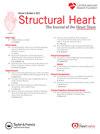Transcatheter Aortic Valve Replacement in Patients With Small Aortic Annulus: An Observational Study
IF 1.4
Q3 CARDIAC & CARDIOVASCULAR SYSTEMS
引用次数: 0
Abstract
Background
The Small Annuli Randomized to Evolut or SAPIEN Trial showed superior hemodynamics of self-expanding valves (SEVs) over balloon-expandable valves (BEVs) in patients with small aortic annuli (SAA). The long-term clinical implications of these hemodynamic differences are unknown.
Methods
We conducted an observational cohort study of patients with SAA, defined as an aortic valve annular area ≤430 mm2 on cardiac computed tomography, who underwent transcatheter aortic valve replacement using BEV or SEV at a single institution between August 2013 and February 2021. Patients undergoing valve-in-valve procedures or alternative access were excluded. Patient-prosthesis mismatch (PPM) was defined as moderate when indexed effective orifice area of 0.65-0.85 cm2/m2 and severe when indexed effective orifice area was <0.65 cm2/m2 (or <0.55 cm2/m2 for body mass index >30 kg/m2). The primary outcome of the study was mortality and major adverse cardiovascular events.
Results
A total of 258 patients were included. The majority were female (81%) with intermediate surgical risk (median STS risk score 4.23); 90 patients (35%) received a BEV (median age 80 years [73, 86]) and 168 (65%) received a SEV (81 years [75, 85], p = 0.699). Comorbidities and risk profiles were well balanced between groups. At 30 days post-transcatheter aortic valve replacement, SEV had lower aortic valve mean gradients (8 mmHg [6, 11] vs. BEV 14 mmHg [10, 18], p < 0.001), lower peak velocities (1.86 m/s [1.60, 2.34] vs. BEV 2.52 m/s [2.14, 2.90], p < 0.001), and were less likely to have PPM (SEV 18% vs. BEV 42% (p < 0.001). At 3 years, both groups had similar mortality (SEV 23% vs. BEV 22%, p = 0.875). PPM was not associated with long-term mortality.
Conclusions
In patients with SAA, we observed no difference in mortality between SEV and BEV up to 3 years after the index procedure, despite early differences in valve hemodynamics.
经导管主动脉瓣置换术治疗小主动脉环:一项观察性研究
研究背景:小主动脉环随机至Evolut或SAPIEN试验显示,在小主动脉环(SAA)患者中,自扩张瓣膜(sev)优于球囊扩张瓣膜(bev)。这些血流动力学差异的长期临床意义尚不清楚。方法:我们对2013年8月至2021年2月在单一机构接受经导管BEV或SEV主动脉瓣置换术的SAA患者进行了一项观察性队列研究,SAA定义为心脏计算机断层扫描主动脉瓣环面积≤430 mm2。接受瓣膜内手术或其他途径的患者被排除在外。当指标有效孔面积为0.65-0.85 cm2/m2时,患者-假体失配(PPM)被定义为中度;当指标有效孔面积为0.65 cm2/m2时,患者-假体失配(PPM)被定义为重度(体重指数为30 kg/m2时,PPM为0.55 cm2/m2)。该研究的主要结局是死亡率和主要不良心血管事件。结果共纳入258例患者。多数为女性(81%),手术风险中等(STS中位风险评分4.23);90例(35%)患者接受了BEV(中位年龄80岁[73,86]),168例(65%)患者接受了SEV(81岁[75,85],p = 0.699)。两组之间的合并症和风险状况平衡良好。经导管主动脉瓣置换术后30天,SEV的主动脉瓣平均梯度较低(8 mmHg[6,11],而BEV为14 mmHg [10,18], p <;0.001),峰值速度较低(1.86 m/s [1.60, 2.34] vs. BEV 2.52 m/s [2.14, 2.90], p <;0.001),并且不太可能有PPM (SEV 18% vs BEV 42%;0.001)。3年时,两组的死亡率相似(SEV 23% vs BEV 22%, p = 0.875)。PPM与长期死亡率无关。结论:在SAA患者中,尽管早期瓣膜血流动力学存在差异,但我们观察到SEV和BEV在指数手术后3年内的死亡率没有差异。
本文章由计算机程序翻译,如有差异,请以英文原文为准。
求助全文
约1分钟内获得全文
求助全文
来源期刊

Structural Heart
Medicine-Cardiology and Cardiovascular Medicine
CiteScore
1.60
自引率
0.00%
发文量
81
 求助内容:
求助内容: 应助结果提醒方式:
应助结果提醒方式:


